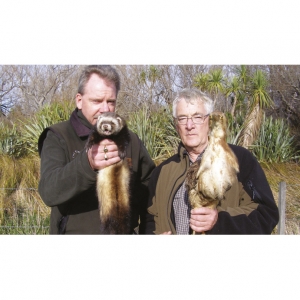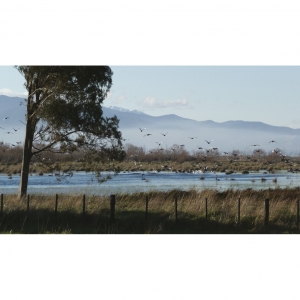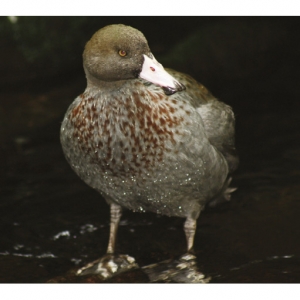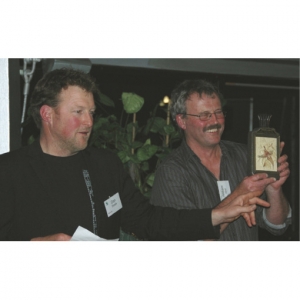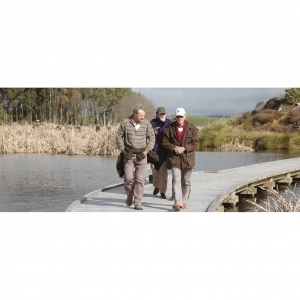Super User
Partnership to help Waituna Lagoon
The improvement of Southland’s Waituna Lagoon and catchment health and wellbeing has become the focus for a number of organisation with statutory roles for this unique site.
The Waituna Lagoon is part of the 20,000ha Awarua Wetland, a designated Ramsar Wetland of International Importance and one of the best remaining examples of a natural coastal lagoon in New Zealand. It is culturally significant to the local Ngāi Tahu people, acknowledged under the Ngāi Tahu claims Settlement Act 1998.
In recognition of the importance of this natural resource, the Department of Conservation (DOC), Environment Southland (ES), the Southland District Council (SDC), Te Rūnanga o Ngāi Tahu and Te Rūnanga o Awarua have formally come together to work alongside the community and other stakeholders for the long-term benefit of Waituna Lagoon, its catchment and community.
Concern was raised in February 2011 about the poor health of the lagoon. Monitoring information from ES and DOC, drawn together for the Report on the State of Southland’s Freshwater Environment, showed it was at risk of flipping into an algae- dominated state.
A multi-pronged emergency response was initiated and remedial practices were put in place, further scientific investigations were undertaken and communication channels established for sharing information.
While flipping remains a potential risk, the focus is now a long-term one to improve the health and wellbeing of the Lagoon, its catchment and community. Formalising the statutory partners’ group is a strong, futurefocused commitment ensuring their actions are aligned and complementary, and that they are working together in the most effective way possible.
Setting and achieving goals will require considerable effort over a number of years. An organised structure to guide efforts allows for a comprehensive and coordinated approach designed to achieve greater improvements than if organisations worked separately and avoids duplication of effort. Working in partnership with the local farmers, the community and industry will be crucial to the success of the project.To recognise the establishment of this formal arrangement, a ceremony took place on August 8 at Te Rau Aroha Marae in Bluff, where the terms of reference to guide the on-going relationship between the partners of the Waituna Partners Group were officially signed.
A web camera recently installed at Waituna Lagoon is providing scientists with regularly updated images of Walker’s Bay, where the lagoon was opened to the sea in late July. Aquatic Ecologist, Dr Andy Hicks said the main benefit of the web camera was to help monitor the lagoon’s opening and closing processes, and to help with the long-term monitoring of environmental conditions in the lagoon.
“The camera allows us to keep an eye on the lagoon without having to physically be there,” he said. Setting up the remotely activated camera was a challenge, plus occasional issues mostly related to the weather. Environment Southland technical staff have now resolved them.
Dr Hicks said the images taken by the camera would be useful for a variety of additional purposes. Recreational boaters would be able to check if lake conditions are suitable for boating, and if the images prove clear enough, the web camera could even be used for monitoring local bird populations.
Pest problem – A24 helps
Blue Duck Station, where DU director Dan Steele and his family live, work, conserve and save ducks, have discovered traps that seem to be super efficient. Here is something about them.
We are pretty excited about the latest technology for dealing with pests; Good Nature’s A24. The A24 is quite different from the DOC200 (350 of which we maintain), and has some advantages over it. The A24 does not need regular maintenance as it automatically re-sets and is therefore great for places with difficult access. The auto- resetting also means they have the potential to catch more as there is no waiting period between kills.
For these reasons we plan to put them in the far back blocks and inaccessible ridges on the station. We have also purchased some counters to indicate when to replace the gas canisters and to give us some catch numbers.
The A24 cannot tell you what it has caught as the carcasses of the creatures rot away or are often carried off by other predators so we will continue to rely on our DoC200s for this. We plan to record A24 catch numbers however and add them to our catch database, linked to our GoogleEarth application.
We believe that anything is worth giving a go in our battle against predators and protecting our whio and other species. We do not plan to replace our DoC200s with A24s but will use them as an addition and in different areas. We are looking forward to seeing results after we have had the traps up for a while.
It is also worth mentioning that the public feel the same, as two of our A24s have been sponsored by visitors as part of our ‘sponsor a trap’ programme!
*Blue Duck Station hosts a number of overseas people they call eco warriors, who visit and work on the station, learning about conservation and helping to protect the Whio.
The traps Department of Conservation uses
Animal pests and predators are a major threat to the survival of New Zealand’s special native flora and fauna.
A wide range of techniques and tools are used to control pests, depending on the threats and the terrain. Ground control is Department of Conservation’s main approach. They use traps, bait stations or culling. It can prove highly effective where the terrain is suitable and regular checks can be made.
It is DoC’s most widely used pest control approach with more than 400,000 hectares under ground control management. Around 80 percent of the Animal Health Board’s operations are ground control. Ground control methods are precise, but are also labour- intensive and expensive.
This website will inform you of three new types of humane kill traps developed by the Department of Conservation and Philip Waddington. These traps are designed to assist conservationists with their protection of native species that have almost been wiped out by introduced predators.
These traps are regarded as innovative and responsible:
The DOC 150 and 200 humanely kill three pest predators - stoats, rats and hedgehogs.
The DOC 250 targets and humanely kills four pest predators - ferrets, stoats, rats and hedgehogs.
Pests best dead
Trapping is the name of the game.
DU member of Pohangina wetlands Gordon Pilone, sent in these shots of a recent catch.
He uses DOC 250 traps to eliminate stoats, rats and hedge hogs.
The kill traps are elevated on a plank on blocks to delay weed invasion and stoats seem to like “running the plank”.
Gordon said a hen egg as bait can be successful even at several weeks old. Also used successfully for stoat kill, is a Timms tunnel trap baited with a fish head.
Predating the predators
To help protect the birds, a trapping programme is underway to get rid of ferrets and other pests to provide a safer environment for rare native birds in the Wairarapa Moana wetlands.
These include Australasian bittern, royal spoonbill and the dabchick. Greater Wellington Regional Council (GWRC) started trapping around Matthews lagoon and Boggy Pond in July. Using covered traps that exclude birds, pest animal officer Steve Playle was successful straight away, catching 13 ferrets and three feral cats in the first month.
“These are large and powerful predators that need to catch and kill regularly. If we can control them around the wetlands, the wetland birds are bound to increase in numbers,” he said.
Hawke’s Bay wetland bird expert and Ducks Unlimited president John Cheyne, said numbers of Australasian bittern were low in a count taken earlier this year, and the work being done by officers like Steve should help raise bird numbers in the wetlands.
“There is a lot of great wetland habitat at Wairarapa Moana, but I only heard eight bitterns calling. There should be more.
Trapping ferrets and feral cats should allow them and all the other ground-nesting birds to breed more successfully.” The trapping programme is part of a wider project to enhance the wetlands around Wairarapa Moana, involving the councils, DoC, iwi, farmers, environmental groups and the community.
Story courtesy of the Greater Wellington Regional Council.
Wairio - Enthusiasm moves project along
“We had a great day – about 1600 plants in the ground!” was the enthusiastic report from Jim Law after a successful planting day at Wairio Wetland in southern Wairarapa.
Mainly flaxes and sedges (about 1200) were planted around the southern and south eastern sides of the new dam wall at Stage 4 and 400 Totora and cabbage trees planted went in at Stage 2.
A good turn-out included Martinborough School students and staff, Taratahi trainees, Rangitane members, Rotary members, Greater Wellington Regional Council (who provided the sausage sizzle), some Rabobank staff, DOC staff and a few locals plus some co-opted farm workers - about 60 folks in all.
More clover seed was sown on the dam wall at Stage 4 by Ross Cottle and Jim Campbell.
A good year so far at the Wairio Wetland – in total just over 4000 shrubs, flaxes and trees in the ground and a great new dam wall trapping about 30 hectares of water in Stage 4. There is more to come with plans advancing for the reticulation of water from Mathews Lagoon and Boggy Pond into the Wairio Wetland.
Kahikatea wetland at Motu
Motu Scenic Reserve is a 20 hectare kahikatea wetland forest located just past Motu township in the Eastern Bay of Plenty.
The reserve is unique as it contains: an oxbow wetland (crescent-shaped lake lying alongside a winding river) and an original kahikatea swamp forest, one of only two percent left in New Zealand.
The remainder of the reserve is alluvial forest with a low canopy of houhere (lacebark) and wheki-ponga (tree fern). Kahikatea (white pine) emerge 30 metres above the canopy. Motu Scenic Reserve is also habitat for aquatic bird species and provides valuable habitat for weka and common bush birds. Visitors can access the reserve, although there are no formal walking tracks.
In 1913 the government approved 70 acres of native bush and lagoon for Motu Scenic Reserve now managed by the Department of Conservation. Visitors from the Motu Hotel often went boating on the lake in the early 1900s when the hotel was at its most popular.
A photo taken by well known local photographer William Crawford in the 1900s features the oxbow lake with Christian Hansen rowing his children and James Whinray (nearby Whinray Scenic Reserve is named after).
DoC undertakes trapping, weed control and restoration planting at the reserve.
The trapping programme targets rats, mustelids and possums. While weed control focuses on Japanese honeysuckle, old man’s beard, English ivy, Japanese walnut and various willow species. Visitors can learn more about problem weeds in the reserve from an information panel installed next to the lake.
Sponsorship from Matua Wines has enabled restoration planting of manuka, flax, karamu, kahikatea and koromiko on the grassy margins of the reserve.
Motu Scenic Reserve is 47km from Opotiki, and 87km from Gisborne, turn off at Matawai on the Motu Road. At the township keep left, cross the bridge over the Motu River and the entrance to the reserve is located on the corner of Motu Road and Phillips Road. Nearby places are the Whinray Scenic Reserve Track and Pakihi Track.
For more information check out doc.govt.nz
Captive breeding keeps up Whio numbers
Peter Russell keeps a watchful eye on Whio to make sure the numbers are kept up and they return as much as possible, to the areas where they started life.
Breeding Results
The past year has been the best to date with 26 ducklings reared and released back into the wild. This was achieved by three pairs, the Auckland pair produced 11, the pair at Peacock Springs having 10 and the Orana pair five. These pairs had all been flock mated. Both the Auckland and Peacock pairs did double clutch which really helps with numbers produced.
Three pairs at Hamilton, Palmerston North and Staglands that I was hoping would produce, did nothing. I hope they do better in the coming season.
Flock Mating
This season we have flock mated four more pairs that gives pairs to Otorohanga, Mt Bruce, Queenstown and another pair at Peacock. I was a bit disappointed with Mt Bruce who took so long in sending male birds to Peacock that the female in the new pair at Peacock laid a clutch of eggs without a male.
It was also disappointing that no wild clutches came in last season to keep on making up more pairs for captive population.
Releases
The first release of 10 was at Egmont National Park on the January 29 with Andrew Glaser of DoC coming over and taking staff through putting transponders in and a video team taking footage of this and the release. We had a group of school children who attended and Andy was in his glory.
The second release was on the Manganui-a-te-ao and it was good to see Alison Beath also of DoC come down to put the transponders in. We released a total of eight birds with two older birds which came from there as juveniles and have only bred once and hadn’t done anything for the last three years. It was a great day. Lots of school children.
The third release was on the Tongariro which also went really well with lots of people and Genesis staff involved. Six birds were released. The last release was back at Egmont on a Saturday so their volunteers could attend as most of them work during the week. There were four birds plus a duckling I had hand reared and then sent to Peacock Springs so it would be brought up with other birds.
It has been so much better now with Air New Zealand sponsorship for moving ducks about and saving costs on breeders and Peacock Springs when sending for release. It is a bit more work for me but it goes with the job.
Quality
Duckling quality is very good and I am sure that the matting’s we are doing with eggs that are coming in is paying off with a very good bird for release.
Deaths for the year
There were seven deaths during the year. Two were neonatal and one a 20-year-old male and another 19-year-old male. We also lost 15 males including one eight-year-old. These males were not in the breeding programme.
The breeding male from Auckland Zoo died after a very good first season. The female is now at Mt Bruce and has been flock mated with the surplus wild males.
Pairs still needed at: 1. Nga Manu, 2. Mt Bruce, 3. Peacock Springs, 4. Kowhai Aviary, 5. Willowbank, 6. Auckland Zoo, and 7. Ron Munro. We need to bring in more clutches this coming season. Releases for next year Egmont wants to carry on releasing next season though we still need to look for new sites. Also returning birds to areas were the clutches of eggs are from.
Auction - fun and drama
New auctioneer gets the dollars
Two successful auctions, one silent, the other noisy and very lively, kept members alert with lots of laughter to boot.
Auctioneer Dan Steele successfully filled the big shoes left by Bob Wood who sadly died in February this year. Dan’s banter was every bit as funny as Bob’s had been, and he cajoled many a bidder to go “just that little bit higher”.
The main auction raised $5255, the silent auction plus the raffle raised $1540. All thanks to those members who donated some amazing items for the auctions and the raffle.
Pekapeka Swamp – an icon for Hawke’s Bay
Our intrepid group of AGM attendees visited the Pekapeka Swamp, squeezed in between the railway on the Eastern side, and State Highway 2 on the West. This area is well known to travellers who use SH2 south of Hastings. Older people who passed this way remember the swamp as being totally overgrown by grey willow. Steve Cave, Operations Environmental Manager for the Hawke’s Bay Regional Council (HBRC) explained the 98ha site is being restored to protect the cultural and historical value but also to help people understand the significance and important part wetlands play.
When Maori arrived in the area about 1530 this peat swamp, part of the limestone area, would have been very different. Its trip down hill started in 1873 with the dumping of rubble, fill and waste. The rail line was built in 1875. Between 1942 and 1970 channels were dug to drain the swamp, and in 1955 SH2 was straightened, cutting through the western side.
In 1970 Pekapeka was made a reserve. Willow control started in 1984 and finally a management plan to restore the wetland was approved by the HBRC. Helicopter and ground spraying targeted the willows. Community and school groups have put in many volunteer hours at the swamp. A clearing programme improved the flow of water through the wetland, and controlled animal and plant pests.
A plain to restore the wetland was approved by the HBRC in 1998. Work included a weir with a fish passage, to manage wetland flow, and funding allowed the site to be developed as a public reserve. Illegal dumping had continued at Pekapeka for many years and as a reminder of how wetlands had been treated it was decided to leave some rubble and reinforcing rods exposed as a reminder of the past.
Pekapeka opened to the public in 2010. Board walks, observation decks and even hides provide access and viewing points. Information boards give background and there is a picnic area. No toilets though. During duck shooting members of a local club use half the area and it is closed to the public. Club members are also involved in a predator control programme.
Steve said red tape, and resource consents often hold up restoration. So far it has cost them $60,000 for consents, eating into the small amount of funding they do receive. Thank goodness for volunteers.



